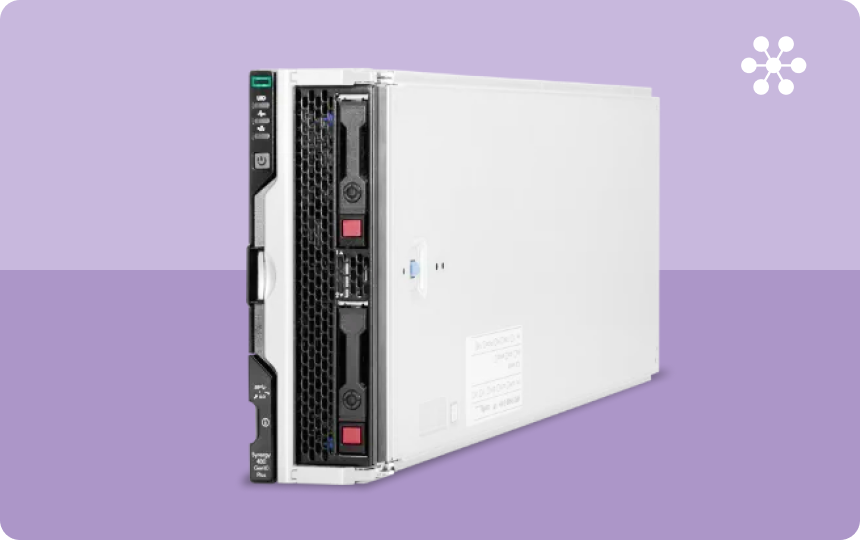Why should you choose the HPE Synergy 480 Gen 10 Plus
The HPE Synergy 480 Gen10 Plus is often discussed in the context of “composable infrastructure”—a term that understandably invites some scepticism. But behind the abstraction, there are architectural and operational characteristics worth unpacking on technical merit alone.
I’m not going to give you a ‘sales pitch’ but give you a breakdown of what the hardware and management stack actually offer—and where they might make a meaningful difference.
System Overview
The Synergy 480 Gen10 Plus is a half-height, dual-socket compute module designed for the HPE Synergy 12000 Frame. It supports 3rd Gen Intel Xeon Scalable processors and up to 6TB of DDR4 memory at 3200 MT/s. With PCIe 4.0 and expanded NVMe support, it aligns with current performance standards and I/O requirements.
Rather than being managed in isolation, the module is designed to operate as part of a resource pool—with compute, storage, and networking provisioned centrally. That integration changes how infrastructure can be scaled and maintained.
Key Technical Features
Granular Resource Allocation
The ability to assign specific compute, storage, and network resources to each workload helps avoid overprovisioning. It’s a practical way to improve utilisation across a fleet of servers, especially where workloads are variable or seasonal.
Deployment Efficiency
Template-based provisioning in HPE OneView enables consistent infrastructure builds. Once templates are defined, they can be reused with minimal manual configuration—reducing both setup time and configuration drift across environments..
Unified Control Pane
With compute, storage, and fabric managed through a single interface, day-to-day operations are less fragmented. This helps reduce overhead associated with siloed infrastructure and makes routine tasks more repeatable.
Platform Lifespan
Support for newer CPUs, memory speeds, and PCIe 4.0 gives the Gen10 Plus more headroom for high-throughput workloads. It’s also better suited to incremental scaling than older hardware, particularly in environments that evolve regularly.
Security Model
The module includes HPE’s Silicon Root of Trust to verify firmware integrity at boot. Runtime firmware validation adds another layer of protection—particularly relevant for environments concerned with persistent firmware threats.
Suitable Workloads
The Gen10 Plus is designed to be flexible. Its performance profile and management tooling make it suitable for a range of workloads:
- Virtualisation: Handles high VM density and works well in large-scale virtualised environments.
- Databases: In-memory and transactional databases benefit from improved memory speeds and NVMe throughput.
- Analytics / HPC: PCIe 4.0 support and GPU expansion make it viable for data-heavy or compute-intensive tasks.
- VDI: GPU options and improved I/O bandwidth support dense virtual desktop deployments.
- DevOps / Containers: Works well with infrastructure-as-code workflows, supporting programmatic provisioning and automation pipelines.
HPE Synergy 480 Gen10 vs Gen10 Plus: Technical Comparison
| Feature | HPE Synergy 480 Gen10 | HPE Synergy 480 Gen10 Plus |
|---|---|---|
| Processor Support | 1st and 2nd Gen Intel Xeon Scalable Processors (Skylake/Cascade Lake) | 3rd Gen Intel Xeon Scalable Processors (Ice Lake) |
| Memory Capacity | Up to 3TB DDR4 at 2666 MT/s | Up to 6TB DDR4 at 3200 MT/s (Source: Bargain Hardware, Server-Parts.eu) |
| PCIe Generation | PCIe 3.0 | PCIe 4.0 (Source: Bargain Hardware, haumoun.com) |
| Storage Support | Supports SATA, SAS, and some NVMe (model dependent) | Enhanced NVMe support for higher throughput and lower latency (Source: Bargain Hardware) |
| GPU Options | Available, but with PCIe 3.0 limitations | Improved GPU support with PCIe 4.0 bandwidth (Source: haumoun.com) |
| Power Efficiency | High efficiency | Slightly improved efficiency (up to 96%) (Source: Bargain Hardware) |
| Boot Options | Traditional boot options | M.2 Hardware RAID Boot Option with dual 480GB NVMe drives included (Source: Insight) |
In practical terms
- Compute: More cores and higher clock speeds make a difference for CPU-bound tasks.
- Memory: Doubling capacity and improving bandwidth increases flexibility for virtualisation and memory-heavy applications.
- PCIe 4.0: Useful for high-speed networking, modern GPUs, and latency-sensitive storage.
- Boot Options: NVMe M.2 RAID is faster and more reliable for OS volumes than legacy approaches.
Final Notes
The Gen10 Plus isn’t a dramatic departure from what came before—it’s a measured evolution, but one with real technical implications. If you’re managing an environment where infrastructure needs to respond quickly to changing demands—and you’re trying to reduce complexity without locking into yet another proprietary abstraction—this module is worth a closer look.
You can configure the HPE Synergy 480 Gen10 Plus to your specifications directly here -
Let’s Talk It Through
If you’re thinking about the HPE Syneregy 480 Gen 10 plus — but are struggling to get a definitive answer from spec sheets or ChatGPT why not give us a call. No hard sell. Just a chance to talk through your options with someone who understands HPE Synergy and who knows how to make challenging budgets go further.






.png)
